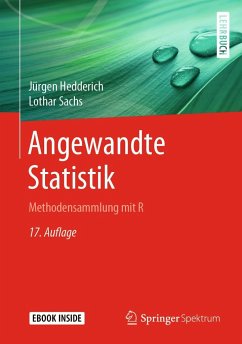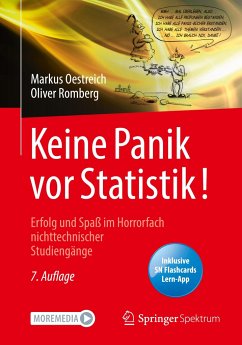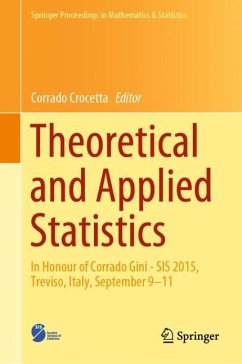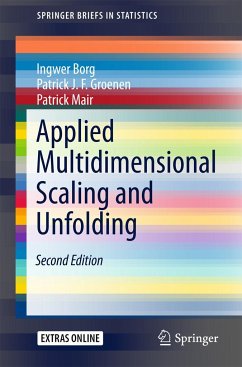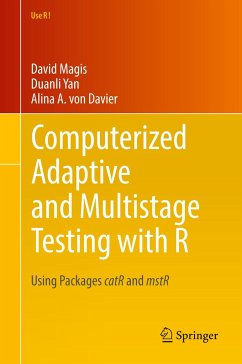
Using Multivariate Statistics

PAYBACK Punkte
33 °P sammeln!
A Practical Approach to using Multivariate Analyses
Using Multivariate Statistics, 6th edition provides advanced undergraduate as well as graduate students with a timely and comprehensive introduction to today's most commonly encountered statistical and multivariate techniques, while assuming only a limited knowledge of higher-level mathematics. This text’s practical approach focuses on the benefits and limitations of applications of a technique to a data set – when, why, and how to do it.
Learning Goals
Upon completing this book, readers should be able to:
Learn to conduct numerous types of multivariate statistical analyses
Find the best technique to use
Understand Limitations to applications
Learn how to use SPSS and SAS syntax and output
Features + Benefits
Provides hands on guidelines for conducting numerous types of multivariate statistical analyses
Maintains a practical approach, still focusing on the benefits and limitations of applications of a technique to a data set — when, why, and how to do it
Presents a comprehensive introduction to today's most commonly encountered statistical and multivariate techniques, while assuming only a limited knowledge of higher-level mathematics.
Datasets available at www.pearsonhighered.com/tabachnick
MySearchLab with eText can be packaged with this text.
MySearchLab provides engaging experiences that personalize learning, and comes from a trusted partner with educational expertise and a deep commitment to helping students and instructors achieve their goals.
eText – Just like the printed text, you can highlight and add notes to the eText or download it to your iPad.
Assessment – Chapter quizzes and flashcards offer immediate feedback and report directly to your gradebook.
Writing and Research – A wide range of writing, grammar and research tools and access to a variety of academic journals, census data, Associated Press newsfeeds, and discipline-specific readings help you hone your writing and research skills.
In this Section:
1. Brief Table of Contents
2. Full Table of Contents
1. BRIEF TABLE OF CONTENTS
Chapter 1 Introduction
Chapter 2 A Guide to Statistical Techniques: Using the Book
Chapter 3 Review of Univariate and Bivariate Statistics
Chapter 4 Cleaning Up Your Act: Screening Data Prior to Analysis
Chapter 5 Multiple Regression
Chapter 6 Analysis of Covariance
Chapter 7 Multivariate Analysis of Variance and Covariance
Chapter 8 Profile Analysis: The Multivariate Approach to Repeated Measures
Chapter 9 Discriminant Analysis
Chapter 10 Logistic Regression
Chapter 11 Survival/Failure Analysis
Chapter 12 Canonical Correlation
Chapter 13 Principal Components and Factor Analysis
Chapter 14 Structural Equation Modeling
Chapter 15 Multilevel Linear Modeling
Chapter 16 Multiway Frequency Analysis
2. FULL TABLE OF CONTENTS
Chapter 1: Introduction
Multivariate Statistics: Why?
Some Useful Definitions
Linear Combinations of Variables
Number and Nature of Variables to Include
Statistical Power
Data Appropriate for Multivariate Statistics
Organization of the Book
Chapter 2: A Guide to Statistical Techniques: Using the Book
Research Questions and Associated Techniques
Some Further Comparisons
A Decision Tree
Technique Chapters
Preliminary Check of the Data
Chapter 3: Review of Univariate and Bivariate Statistics
Hypothesis Testing
Analysis of Variance
Parameter Estimation
Effect Size
Bivariate Statistics: Correlation and Regression.
Chi-Square Analysis
Chapter 4: Cleaning Up Your Act: Screening Data Prior to Analysis
Important Issues in Data Screening
Complete Examples of Data Screening
Chapter 5: Multiple Regression
General Purpose and Description
Kinds of Research Questions
Limitations to Regression Analyses
Fundamental Equations for Multiple Regression
Major Types of Multiple Regression
Some Important Issues.
Complete Examples of Regression Analysis
Comparison of Programs
Chapter 6: Analysis of Covariance
General Purpose and Description
Kinds of Research Questions
Limitations to Analysis of Covariance
Fundamental Equations for Analysis of Covariance
Some Important Issues
Complete Example of Analysis of Covariance
Comparison of Programs
Chapter 7: Multivariate Analysis of Variance and Covariance
General Purpose and Description
Kinds of Research Questions
Limitations to Multivariate Analysis of Variance and Covariance
Fundamental Equations for Multivariate Analysis of Variance and Covariance
Some Important Issues
Complete Examples of Multivariate Analysis of Variance and Covariance
Comparison of Programs
Chapter 8: Profile Analysis: The Multivariate Approach to Repeated Measures
General Purpose and Description
Kinds of Research Questions
Limitations to Profile Analysis
Fundamental Equations for Profile Analysis
Some Important Issues
Complete Examples of Profile Analysis
Comparison of Programs
Chapter 9: Discriminant Analysis
General Purpose and Description
Kinds of Research Questions
Limitations to Discriminant Analysis
Fundamental Equations for Discriminant Analysis
Types of Discriminant Analysis
Some Important Issues
Comparison of Programs
Chapter 10: Logistic Regression
General Purpose and Description
Kinds of Research Questions
Limitations to Logistic Regression Analysis
Fundamental Equations for Logistic Regression
Types of Logistic Regression
Some Important Issues
Complete Examples of Logistic Regression
Comparison of Programs
Chapter 11: Survival/Failure Analysis
General Purpose and Description
Kinds of Research Questions
Limitations to Survival Analysis
Fundamental Equations for Survival Analysis
Types of Survival Analysis
Some Important Issues
Complete Example of Survival Analysis
Comparison of Programs
Chapter 12: Canonical Correlation
General Purpose and Description
Kinds of Research Questions
Limitations
Fundamental Equations for Canonical Correlation
Some Important Issues
Complete Example of Canonical Correlation
Comparison of Programs
Chapter 13: Principal Components and Factor Analysis
General Purpose and Description
Kinds of Research Questions
Limitations
Fundamental Equations for Factor Analysis
Major Types of Factor Analysis
Some Important Issues
Complete Example of FA
Comparison of Programs
Chapter 14: Structural Equation Modeling
General Purpose and Description
Kinds of Research Questions
Limitations to Structural Equation Modeling
Fundamental Equations for Structural Equations Modeling
Some Important Issues
Complete Examples of Structural Equation Modeling Analysis.
Comparison of Programs
Chapter 15: Multilevel Linear Modeling
General Purpose and Description
Kinds of Research Questions
Limitations to Multilevel Linear Modeling
Fundamental Equations
Types of MLM
Some Important Issues
Complete Example of MLM
Comparison of Programs
Chapter 16: Multiway Frequency Analysis
General Purpose and Description
Kinds of Research Questions
Limitations to Multiway Frequency Analysis
Fundamental Equations for Multiway Frequency Analysis
Some Important Issues
Complete Example of Multiway Frequency Analysis
Comparison of Programs
Using Multivariate Statistics, 6th edition provides advanced undergraduate as well as graduate students with a timely and comprehensive introduction to today's most commonly encountered statistical and multivariate techniques, while assuming only a limited knowledge of higher-level mathematics. This text’s practical approach focuses on the benefits and limitations of applications of a technique to a data set – when, why, and how to do it.
Learning Goals
Upon completing this book, readers should be able to:
Learn to conduct numerous types of multivariate statistical analyses
Find the best technique to use
Understand Limitations to applications
Learn how to use SPSS and SAS syntax and output
Features + Benefits
Provides hands on guidelines for conducting numerous types of multivariate statistical analyses
Maintains a practical approach, still focusing on the benefits and limitations of applications of a technique to a data set — when, why, and how to do it
Presents a comprehensive introduction to today's most commonly encountered statistical and multivariate techniques, while assuming only a limited knowledge of higher-level mathematics.
Datasets available at www.pearsonhighered.com/tabachnick
MySearchLab with eText can be packaged with this text.
MySearchLab provides engaging experiences that personalize learning, and comes from a trusted partner with educational expertise and a deep commitment to helping students and instructors achieve their goals.
eText – Just like the printed text, you can highlight and add notes to the eText or download it to your iPad.
Assessment – Chapter quizzes and flashcards offer immediate feedback and report directly to your gradebook.
Writing and Research – A wide range of writing, grammar and research tools and access to a variety of academic journals, census data, Associated Press newsfeeds, and discipline-specific readings help you hone your writing and research skills.
In this Section:
1. Brief Table of Contents
2. Full Table of Contents
1. BRIEF TABLE OF CONTENTS
Chapter 1 Introduction
Chapter 2 A Guide to Statistical Techniques: Using the Book
Chapter 3 Review of Univariate and Bivariate Statistics
Chapter 4 Cleaning Up Your Act: Screening Data Prior to Analysis
Chapter 5 Multiple Regression
Chapter 6 Analysis of Covariance
Chapter 7 Multivariate Analysis of Variance and Covariance
Chapter 8 Profile Analysis: The Multivariate Approach to Repeated Measures
Chapter 9 Discriminant Analysis
Chapter 10 Logistic Regression
Chapter 11 Survival/Failure Analysis
Chapter 12 Canonical Correlation
Chapter 13 Principal Components and Factor Analysis
Chapter 14 Structural Equation Modeling
Chapter 15 Multilevel Linear Modeling
Chapter 16 Multiway Frequency Analysis
2. FULL TABLE OF CONTENTS
Chapter 1: Introduction
Multivariate Statistics: Why?
Some Useful Definitions
Linear Combinations of Variables
Number and Nature of Variables to Include
Statistical Power
Data Appropriate for Multivariate Statistics
Organization of the Book
Chapter 2: A Guide to Statistical Techniques: Using the Book
Research Questions and Associated Techniques
Some Further Comparisons
A Decision Tree
Technique Chapters
Preliminary Check of the Data
Chapter 3: Review of Univariate and Bivariate Statistics
Hypothesis Testing
Analysis of Variance
Parameter Estimation
Effect Size
Bivariate Statistics: Correlation and Regression.
Chi-Square Analysis
Chapter 4: Cleaning Up Your Act: Screening Data Prior to Analysis
Important Issues in Data Screening
Complete Examples of Data Screening
Chapter 5: Multiple Regression
General Purpose and Description
Kinds of Research Questions
Limitations to Regression Analyses
Fundamental Equations for Multiple Regression
Major Types of Multiple Regression
Some Important Issues.
Complete Examples of Regression Analysis
Comparison of Programs
Chapter 6: Analysis of Covariance
General Purpose and Description
Kinds of Research Questions
Limitations to Analysis of Covariance
Fundamental Equations for Analysis of Covariance
Some Important Issues
Complete Example of Analysis of Covariance
Comparison of Programs
Chapter 7: Multivariate Analysis of Variance and Covariance
General Purpose and Description
Kinds of Research Questions
Limitations to Multivariate Analysis of Variance and Covariance
Fundamental Equations for Multivariate Analysis of Variance and Covariance
Some Important Issues
Complete Examples of Multivariate Analysis of Variance and Covariance
Comparison of Programs
Chapter 8: Profile Analysis: The Multivariate Approach to Repeated Measures
General Purpose and Description
Kinds of Research Questions
Limitations to Profile Analysis
Fundamental Equations for Profile Analysis
Some Important Issues
Complete Examples of Profile Analysis
Comparison of Programs
Chapter 9: Discriminant Analysis
General Purpose and Description
Kinds of Research Questions
Limitations to Discriminant Analysis
Fundamental Equations for Discriminant Analysis
Types of Discriminant Analysis
Some Important Issues
Comparison of Programs
Chapter 10: Logistic Regression
General Purpose and Description
Kinds of Research Questions
Limitations to Logistic Regression Analysis
Fundamental Equations for Logistic Regression
Types of Logistic Regression
Some Important Issues
Complete Examples of Logistic Regression
Comparison of Programs
Chapter 11: Survival/Failure Analysis
General Purpose and Description
Kinds of Research Questions
Limitations to Survival Analysis
Fundamental Equations for Survival Analysis
Types of Survival Analysis
Some Important Issues
Complete Example of Survival Analysis
Comparison of Programs
Chapter 12: Canonical Correlation
General Purpose and Description
Kinds of Research Questions
Limitations
Fundamental Equations for Canonical Correlation
Some Important Issues
Complete Example of Canonical Correlation
Comparison of Programs
Chapter 13: Principal Components and Factor Analysis
General Purpose and Description
Kinds of Research Questions
Limitations
Fundamental Equations for Factor Analysis
Major Types of Factor Analysis
Some Important Issues
Complete Example of FA
Comparison of Programs
Chapter 14: Structural Equation Modeling
General Purpose and Description
Kinds of Research Questions
Limitations to Structural Equation Modeling
Fundamental Equations for Structural Equations Modeling
Some Important Issues
Complete Examples of Structural Equation Modeling Analysis.
Comparison of Programs
Chapter 15: Multilevel Linear Modeling
General Purpose and Description
Kinds of Research Questions
Limitations to Multilevel Linear Modeling
Fundamental Equations
Types of MLM
Some Important Issues
Complete Example of MLM
Comparison of Programs
Chapter 16: Multiway Frequency Analysis
General Purpose and Description
Kinds of Research Questions
Limitations to Multiway Frequency Analysis
Fundamental Equations for Multiway Frequency Analysis
Some Important Issues
Complete Example of Multiway Frequency Analysis
Comparison of Programs
This text takes a practical approach to multivariate data analysis, with an introduction to the most commonly encountered statistical and multivariate techniques. Using Multivariate Statistics provides practical guidelines for conducting numerous types of multivariate statistical analyses. It gives syntax and output for accomplishing many analyses through the most recent releases of SAS and SPSS. The book maintains its practical approach, still focusing on the benefits and limitations of applications of a technique to a data set when, why, and how to do it. Overall, it provides advanced students with a timely and comprehensive introduction to today's most commonly encountered statistical and multivariate techniques, while assuming only a limited knowledge of higher-level mathematics.




